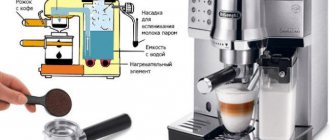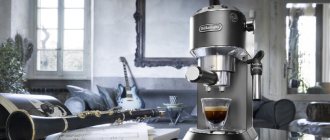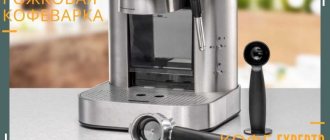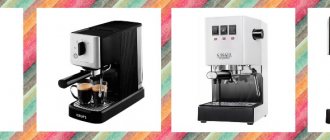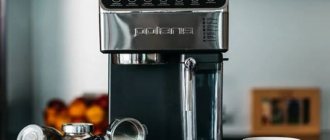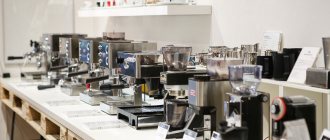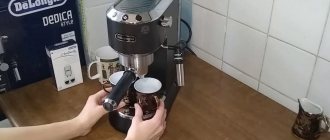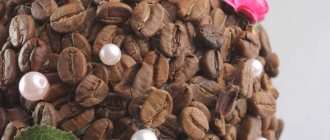There are many types of coffee brewing machines. They can be electric or not require electricity to operate. Depending on the degree of automation, there are automatic, semi-automatic and super-automatic.
Manual coffee makers, that is, coffee makers without heating elements, after filling with ground coffee and water, require installation on the stove.
A coffee machine or coffee maker is a device designed for brewing coffee.
The following types of coffee makers exist:
Drip (Americano, filter) coffee maker
The device, invented at the beginning of the 19th century by a church minister, has still changed little in design and principle of operation.
An electrical device using a filtration method and a percolation process consists of two vessels: for water and for the finished drink. However, in the low-price segment there may be no vessel for collecting the finished coffee drink.
The heated water in the vessel rises through a vertical tube. Further, percolating through the filter with ground coffee, it picks up aromatic substances from there. Then it goes into the compartment for the finished drink, located under the filter.
Drip coffee makers can only make strong or mild Americano or, in other words, filter coffee.
The strength of the coffee produced in such a device depends on the degree of grinding of the beans and its type. Coarsely ground coffee powder in such a machine produces unsaturated coffee, while finely ground coffee produces bitter coffee.
People who love coffee that is not dangerous to health, not strong, with low caffeine content and in large quantities.
Simple and inexpensive drip coffee makers are purchased both for home kitchens and for professional purposes in small coffee establishments. Drip coffee makers are popular in the Nordic countries and the USA.
Drip coffee makers are equipment made of heat-resistant glass, a thermos, or a body made of plastic or stainless steel. For home cooking they produce volumes from 1-2.5 liters, for catering establishments or coffee shops from 5 to 40 liters.
Modern drip coffee makers were achieved through the modernization of percolators.
Percolators were produced in large volumes for use in catering establishments and cafes. Equipment with a volume of up to 15 liters were universal, cheaper and simpler than drip devices. The drink in percolators turned out bitter due to direct contact of the water with boiling water at 100°C. At this temperature, essential oils and caffeine in coffee are destroyed. Therefore, there was a need to obtain other equipment in the form of drip coffee makers.
Coffee makers operating without an electrical connection:
Structure and components of a coffee machine
Brewing machines have several main parts and are different from coffee makers. There is no fundamental difference between the main elements; there are only design differences depending on the method of preparing the drink. All parts of coffee machines can be linked into functional parts that perform specific actions.
A special container is used to fill and store ground coffee powder or prepared beans. For carob coffee machines, this will be the horn itself (that’s why the machine is called that), and universal machines are equipped with containers into which the beans are poured.
The brewing system is responsible for brewing coffee.
The strength of the drink will depend on the grind of the coffee beans - the finer the grind, the stronger the drink.
Universal coffee machines have a grinding function, so the taste of the drink will depend on their serviceability. Devices operating on capsules, pods or using ground coffee powder are not responsible for the strength of the drink.
Universal machines grind coffee themselves and compact it
The water unit is the system responsible for storing water, heating it and supplying water to the brewing system. The water supplied for making coffee should not be boiling, but heated to a temperature of 80-90 degrees Celsius. Some coffee machines do not use water for brewing, but steam supplied under high pressure.
To maintain hygienic cleanliness, any coffee machine has a tray into which spilled water or the drink itself is drained, and waste is also drained there during automatic cleaning of the machine in universal devices.
Remaining coffee and unused water flow into the drip tray.
To control all processes in coffee machines, there is an electronic microcircuit that connects all components into a single mechanism and controls the process. The machine is controlled using an electronic panel; there is also an indication of the preparation of the drink.
The design of coffee machines varies from type to type and from manufacturer to manufacturer. Additional components and elements in coffee machines are installed depending on the type of device.
In universal machines, a container is installed to collect used coffee, but in carob machines there is no such design - the coffee is poured into the cone, which is shaken out after use.
A capsule machine is equipped with a holder for capsules or pods, and a universal machine is equipped with a filter for accumulating coffee powder after grinding.
Cezva (Turkish)
A turk or cezve (from the Turkish Cezve) is a cone-shaped, thick-walled container, the bottom of which is widened downward. This coffee maker has a very narrow neck, which is designed to retard the evaporation of coffee aromatic compounds. Turks are equipped with a long handle made of non-thermal conductive materials. The cezve is made of ceramics, stainless steel and other metals such as aluminum, copper, brass. Turks or cezves are made with a volume of 1 to 10 cups. The number of servings or volume is indicated on the bottom of the vessel. In a Turk, very finely ground coffee is used to prepare Turkish or Arabic coffee. When preparing, ground coffee beans, spices and sugar are poured into the cezve, filled with the required amount of water and boiled on a stove or on a special tray with sand, without bringing it to a boil.
Additional functions
Fast steam - the ability to almost instantly get steam for frothing milk. Without this feature, the coffee machine takes some time to heat the water to a boil and turn it into steam.
Automatic shutdown – the ability of the device to switch itself off after 3-4 hours of continuous operation. Especially useful for those who often forget to turn off electrical appliances.
Coffee temperature adjustment – you can set the desired temperature for making coffee. For expresso coffee makers, the best option is 90-95 ° C.
Adjusting the coffee strength – allows you to select the preferred strength of the drink. It is carried out by adjusting various parameters: water temperature, the number of grains per serving, due to a special brewing system.
Adjusting the volume of portions is done by changing the amount of hot water. Customizable depending on preference: from a large cup to a small coffee cup. It should be remembered that large amounts of strong coffee are harmful to health.
Water level indicator - allows you to ensure that there is always enough water in the tank. Some models have a scale indicating the number of spoons that need to be poured for a given water level.
Grinding degree adjustment – allows you to select the time required for water to pass through the coffee tablet. Depending on this parameter, the preparation time of the drink changes, which affects its taste. Grinding too fine gives a burnt taste, too coarse - sour. The optimal time is 25 seconds (plus or minus 3 seconds).
Water hardness adjustment – allows you to control the water hardness, which affects the formation of scale in the boiler.
Many coffee makers have 4 water hardness settings:
- Mode 1 – up to 3 mg/l;
- Mode 2 – 3-3.5 mg/l;
- Mode 3 – 3.5-4 mg/l;
- Mode 4 – 4-4.5 mg/l.
Hot water supply – allows you to prepare tea or other hot drink. This feature is provided in espresso coffee makers. Water is supplied from a special tap or steam outlet. Temperature – 90 °C (sometimes adjustable).
Simultaneous preparation of two cups - useful if the device is used by several people. To brew two cups at the same time, the coffee maker must have two taps dispensing coffee. Some espresso coffee makers and combination devices boast this option.
Strength control – allows you to control the strength of your coffee. There are two modes: “soft” and “strong” coffee.
Pre-wetting – Before preparation, the ground coffee is wetted to improve the taste and aroma of the drink.
Automatic descaling (decalcification) – the coffee maker automatically cleans itself of scale, which shortens its service life.
Remote control – allows you to give commands to the coffee maker at a distance using smartphones or tablets that have a special application. Control is carried out via wireless interfaces Wi-Fi and Bluetooth.
French press
The French press is the simplest of all coffee brewing devices and gives you a basic level of coffee making skill.
They maintain the correct water temperature throughout the entire process, which affects the quality of the coffee. Drip machines and percolators often heat the water quickly and cool it just as quickly, so that the correct temperature is only reached halfway through the process rather than throughout the brewing cycle. Moreover, paper filters in drip machines absorb most of the oils in coffee powder, which give the aroma of coffee. The device uses 60-70 grams of coffee per liter of water.
Types of professional coffee machines
For professional use, it is better to consider other types of coffee machines that are designed for the appropriate tasks and can handle large volumes of daily work.
Lever coffee machines
In Russian establishments, lever machines are extremely rare. This is due to the peculiarities of their operation, the high cost and complexity of repairs.
Lever coffee machines are also called lever coffee machines. They start making coffee manually by pressing a special lever. Only an experienced barista who has undergone special training and has the skill can work with such a device.
Lever coffee machine.
Peculiarities
Coffee machines of this type are only suitable for establishments with a small flow of customers, since they take a little longer to prepare coffee. This feature is inherent in all models of lever machines. Some of them have other notable features. For example, the ability to work without electricity, instead of which gas is used.
Most often, such coffee machines increase the prestige of the establishment. However, they require experienced baristas on staff, which can cost a lot of money for the business owner.
Semi-automatic coffee machine
These coffee machines are considered classic. They are very common in Europe and are used in many coffee shops.
Semi-automatic machines differ from automatic ones in their appearance. On the front side they lack displays and dozens of controls. There are only basic buttons and arrow gauges.
Despite the presence of an electric pump, which eliminates the need to press the lever, operating the coffee machine still has its difficulties. The barista must carefully monitor the parameters of the drink and the filling of the cups.
Semi-automatic coffee machine.
Peculiarities
The main feature of this type of coffee machine is the difficulty of operation. They don’t cost that much money and don’t require a lot of maintenance, but to use them you’ll have to find an experienced barista, which won’t be that cheap. A person with insufficient professionalism will not be able to make delicious coffee using such a machine.
Automatic coffee machine
Automatic coffee machines always have a modern design, and electronic control elements are installed on their front panel. Working with them is easier, since most tasks are regulated by the device itself. However, there are some nuances.
An automatic coffee machine prepares coffee itself without the participation of a barista, with the exception of filling the container with raw materials and the water boiler. You just need to press a button, after which the cup will be filled with the finished drink. But such coffee machines must be configured separately for each type of coffee variety and grind. Therefore, having an experienced barista on staff will become a necessity.
Automatic coffee machine.
Peculiarities
This type of coffee machine will have to be set up every morning. After this, even a person without much experience can use it, since it will be almost impossible to spoil the drink.
Automatic coffee machines often have additional functions. The cup counter is considered the most useful, which helps keep records and eliminates dishonest actions by employees.
Super automatic coffee machine
Purchasing a super-automatic coffee machine will provide your establishment with high-quality espresso-based coffee. Such devices are easy to use and have a lot of additional functions.
This type of machine operates automatically and does not require anything other than access to water and coffee raw materials. Even the client himself can prepare a delicious drink. Therefore, super-automatic coffee machines can be installed in self-service coffee shops.
On the front of such machines there is a panel with drink options. Just press a button, after which the coffee will be automatically prepared in compliance with all the nuances. The only disadvantage of such a device may be the cost.
Super automatic coffee machine.
Peculiarities
Super-automatic machines have built-in containers for coffee beans, automatic coffee grinders and thermal milk containers. Many models also independently remove waste materials without interrupting work. Luxury coffee machines are equipped with built-in computers and can be controlled wirelessly.
Coffee prepared in a super-automatic machine is considered close to ideal. Many believe that it can be second in quality only to a drink from a professional barista with extensive experience and advanced skills.
If you notice an error, a non-working video or link, please select a piece of text and press Ctrl+Enter .
0
Aeropress
AeroPress is the best alternative to a French press. This is a small, simple, portable device. It will produce a very competitive, frothy cup of coffee, with a quality somewhere between French press coffee and espresso. AeroPress is one of the latest discoveries in the world of coffee. It requires very little space. In fact, the AeroPress looks more like a medical vessel than a kitchen appliance. But that's the beauty of its size. The whole process is marginally more complicated than loading a French press. The cup will be ready faster than using a French press.
How about a ready-made drink?
If you care what kind of coffee you drink, you will decide on your choice once and for all.
When you decide which preparation method is best, you also take into account the final taste of the drink. With a French press, you control all stages of preparation and can be sure that you will get the perfect drink for yourself.
You pour your favorite coffee beans into the coffee machine. But filtering inside the device will remove most of the aroma. Many coffee lovers complain that the drink from the coffee machine is light and tasteless.
But don’t forget that the coffee machine will prepare hot coffee for you at any time. A French press is the opposite. The longer the drink sits in it, the more bitter it will taste.
Handpresso
Handpresso (from the English word hand - “hand”) is a miniature model of a coffee maker. It can fit in one person's hand. There is a piston pump inside that creates a pressure of 9 bar. You need to pour ground coffee into the coffee maker when the pressure gauge is at the green mark and add hot water. Then you need to close the filter cover. The finished coffee is poured into the cup at the touch of a button.
Manual portable coffee makers have the advantage of being small in size. You can take them on the road, on any trip. They operate without electricity.
Purover
The English verb pour over gives its name to the method of preparing coffee and the device. The idea was born in Japan from the tea ceremony. The Hario brand from this country produces special kettles for brewing coffee. In addition, pour overs are produced under the KitchenAid brand. And the Bodum company discontinued its pour-over model.
Hario's equipment consists of a special kettle with a narrow, long and curved spout, a pour-over funnel with a filter.
Brewing coffee in a pour over involves pouring water from a kettle with a curved spout onto a filter with coffee powder in a spiral, in a thin stream, moving in a circle, from the perimeter to the center. The finished coffee is collected in a container under the filter. This drink reveals the taste of the coffee bean better. You need to use medium grind coffee powder. The KitchenAid brand pour-over is electric and has a disc installed under the coffee vessel to heat the drink.
Chemex
This method of brewing coffee was invented by an American chemist. A Chemex is a glass container that looks like an hourglass and a pour-over. In fact, it is a flask with a spout on which a glass funnel is installed, which are secured with a leather strap. The disadvantage of the device is its fragility. Hot water and ground coffee come into contact for a short time, resulting in a waterier and less flavorful drink.
Coffee used
Beans are the original state of coffee, in which all the richness of taste and aroma is preserved. Coffee makers for beans are equipped with a coffee grinder and allow you to choose the type of beans to grind and their quantity. This option is appreciated by coffee gourmets, but it is also the most difficult to prepare.
Ground – powdered coffee obtained by grinding beans. In the ground substance, a significant part of the taste is lost. Most coffee makers support working with ground coffee. This solution is characterized by an optimal balance between taste and complexity of preparation.
Many coffee makers are designed to use beans and ground coffee.
Capsules are ground coffee packed in a capsule. The weight of the capsule is 7-9 g. This form of release simplifies the preparation of the drink: the user is required to install the capsule in the device and turn on the desired program. The capsules are only suitable for capsule coffee makers.
Pods are ground coffee packed in a paper filter. The weight of one bag is 7-9 g. Coffee in pods is just as easy to prepare as capsule coffee. Similar to the previous version, the pods are compatible only with special pod coffee makers. It is argued that pod coffee is not inferior in taste to capsule coffee, but is cheaper.
Important: the capsule and pod form of release does not allow the user to control the process of preparing the drink and influence its taste. There is also the problem of compatibility of capsules and coffee makers from different manufacturers.
Vietnamese Phin Coffee Filter
To brew Vietnamese coffee, use simple Phin. It is called a Vietnamese coffee filter, or coffee press, and comes in sizes ranging from 6, 8, 11 to 15 ounces. This is a simple device for brewing coffee.
It consists of a saucer with a strainer for a glass, a hopper, a press and a lid. The grind should be medium.
Geyser (Italian coffee pot) coffee maker
This type of coffee maker is called an Italian coffee pot, moka coffee maker, steam coffee maker or geyser-type coffee maker. They were patented by Luigi de Ponti in 1933, and mass production was launched by Italian entrepreneur Alfonso Bialetti. Since then, the Bialetti Moka Express has been produced unchanged.
The operating principle is similar to a percolator. Not one, but two containers are the main difference. The installation consists of three sections:
- Lower water tank;
- filter for ground coffee;
- upper container for ready-made coffee.
Coffee makers differ from each other in case material, power, capacity of containers and additional functionality.
The name of the model reflects the principle of operation. The water is heated in the lower container, expanding under increased pressure and entering a funnel-shaped tube. The water then passes through the ground coffee on the filter, extracts the necessary components of the coffee from there, and, like water from a geyser, erupts through a tube into the upper coffee pot.
Geyser-type coffee makers are produced electric (with an internal heating source) and without an internal heating source, which are placed on stoves. In a geyser coffee maker, coffee is prepared in 5 to 10 minutes.
A classic geyser coffee maker has an octagonal bottom vessel. They produce models with a steel or plastic coffee vessel, with a heat-protective handle and a hinged lid. At the foot of the lower vessel in front there is a control panel. The amount of drink depends on the capacity of the device. You can make half a jug or a full jug of coffee.
Coffee brewing occurs in several stages:
- Filtered water is poured into the lower container to a certain level.
- Medium grind coffee is poured into the filter. The powder should be slightly smoothed, there is no need to compact it.
- A filter with ground coffee is installed above the container with water, and a coffee pot is placed on top. Then the coffee maker is either plugged in or placed on the stove. The device turns off manually after a hissing sound appears.
Coffee machines
- Carob coffee makers
- Pod coffee makers
- Capsule coffee machines
Automatic coffee machines
Automatic coffee makers with a built-in coffee grinder are responsible for the entire coffee preparation cycle. They are called espresso makers. The grinding processes, throwing spent coffee tablets into a special container, supplying coffee into cups, everything is controlled independently. Automatic coffee machines are the main type of coffee makers for home (small) and professional (large) use. The price of such devices depends on the power, additional functions and purpose.
Water is poured into automatic coffee machines, the beans are poured into the built-in coffee grinder and the start button is pressed.
At the dawn of the coffee machine, there were huge tower-like devices. And nowadays, home-use devices are so compact that they can fit in any kitchen.
In a coffee machine, all processes and actions are automated and they were originally created for making espresso, using steam under pressure to a filter with ground beans. Modern models can prepare many other types of coffee. Most are equipped with a device - a cappuccino maker for whipping milk foam using hot steam manually or automatically.
Espresso coffee machines
Espresso coffee machines are compression devices. This complex and expensive equipment prepares espresso and drinks based on it. The first espresso coffee machine was patented by Angelo Moriondo, and Luigi Bezzera improved his invention. He added a safety valve, brew groups, milk frother steam tap and removable filter holders to the forerunner of coffee machines. It is thanks to the horns that the devices were dubbed carob coffee machines. They are most often called that in Russia. In the West they mainly call espresso coffee machines.
In the first coffee machines, the pressure of 1.5 atmospheres created when heated in a large boiler forced water and steam through a layer of ground coffee. Achille Gaggia overcame a pressure of 1.5-2 atmospheres. His coffee machine consisted of a plunger cylinder that drove a lever. When you pressed it, 8-10 atmospheric pressure arose in the cylinder. The plunger coffee maker produced an aromatic, rich, strong drink with thick foam.
The 28-30 milliliter volume of an espresso cup was adopted as a standard because the plunger cylinder of the Achille Gaggia espresso coffee maker could hold that amount of water. Steam taps and boiling water taps made it possible to prepare espresso and other drinks.
In 1961, Ernesto Valente created a pump-action coffee maker. The pressure in it was created by an electric pump. Pump machines provide a maximum pressure of 15 atmospheres. The standards of the Italian National Espresso Institute (INEI) state that 9-10 bar of pressure is sufficient to prepare a classic espresso. In a 20-30 second extraction cycle, this pressure is enough to produce an excellent drink.
In espresso coffee makers, the mechanical piston is replaced by a pump, the boiler is replaced by thermal blocks-heat exchangers, which reduce the heating time of water.
According to Italians, the quality of real espresso is determined by the right blend and roasting (Miscela), the right grinding (Macinazione), the right coffee machine (Macchina), and the experienced hand of the barista (Mano).
Semi-automatic coffee machines are in demand by professionals in the HoReCa segment as coffee machines for cafes, bars and restaurants.
Criterias of choice
A coffee machine is a device that is purchased for a long time, so choose which one you want in advance, with the functionality that is preferable to you. It is not difficult to make the right choice if you know what the device consists of and what functions it has.
Millstone
These are the elements responsible for grinding coffee beans; they can be made of steel or ceramic:
- Steel ones are considered reliable; it is safe for them to get into the raw materials from third-party small objects, like pebbles. Disadvantage - they can burn out the grind due to heating, which will certainly affect the taste of the drink.
- Ceramic. They do not heat up, which means they do not burn out raw materials, and they operate more quietly. The disadvantage is fragility, they can break if hit by the same pebbles.
Fine grinding of beans is used in making espresso; here you need fast brewing and sufficient strength. The large one is used in making Americano.
Control type
Coffee machines can be controlled in two main ways:
- Mechanical . The instrument has one or more control switches.
- Electronic . The machine has a touch panel and buttons for setting up the program.
The first control is simpler, more reliable, and does not involve program freezes or glitches. The second option benefits from greater functionality, convenience, style and design.
Water heater
The device for heating water here is a boiler or thermoblock:
- After the boiler
- The thermoblock uses only the amount of water needed for brewing and simply stops after heating.
The disadvantages of the boiler are obvious. Water that is constantly heated loses its taste, and this certainly affects the quality of the drink. In addition, plaque will collect faster on the walls of the container. This means you will need to clean it more often. The second option for choosing a heater is more economical; the coffee tastes always natural.
For home use, it is more advisable to choose a thermoblock. Heating is faster for one cup. The boiler type of heater is more suitable for offices where performance, rather than speed, is needed.
Brand
Consumer demand indicates that the brand name plays a significant role in the choice. This is a kind of quality mark and evidence that the coffee machine is reliable and will last a long time. Leading brand companies include:
- Krups;
- Delonghi;
- Jura;
- Gaggia;
- Saeco;
- Bosch.
Power and performance
These two parameters are considered basic, and before choosing a coffee machine for home use, attention is paid to them first. The higher the power settings, the faster the machine will prepare coffee. But at the same time, the taste and strength of the drink will significantly decrease. This is explained by the fact that at high power the water will pass through the grinding too quickly, not having time to absorb the aroma and taste.
Capacity affects the number of people willing to consume the drink. That is, the more family members drink coffee, the more productivity will be required.
The optimal choice for a family: productivity – 30 cups of coffee is enough. Power – 1000-1500 W. For an ordinary family, these indicators are quite enough. It is not recommended to buy higher, as this will cause the taste of the coffee to be lost.
Big or small – size matters
Owners of a large kitchen and a large family can pay attention to large-sized coffee machines. Compact sizes are better suited for an ordinary city kitchen. To choose the right one, you need to know how many people live in the apartment and how often they drink coffee.
According to statistics, for an ordinary family a car with dimensions of 19.5 × 34 × 47.7 (w × d × h in cm) will be sufficient, respectively.
The best is the one that best meets all your requirements and needs. If you choose correctly, it will be a faithful assistant, especially in the mornings, when there is not enough time and you really want to drink coffee.
Brewing mechanism cleaning system
The brewing mechanism is often called the heart of the coffee machine. The quality of the prepared drink, the preservation of the aroma and all the beneficial substances that are in it depend on it. The choice of an automatic coffee maker should also be based on the availability of this option.
Availability of a cappuccino maker
Cappuccino lovers need to pay attention before choosing a machine whether it can prepare it. Not every machine may have a cappuccino maker, but most models have this function. The purpose of this device is to whip milk into foam efficiently. May be:
- Mechanical, where the milk is whipped separately from the coffee container using steam.
- Automatic. The device itself whips up thick foam from the milk and delivers it into the cup.
Functionality
The differences between one model of coffee brewer and another are:
- grinding degrees of coffee beans 3-12;
- temperature of the drink: hot, scalding or warm;
- strength and richness;
- volume of 1 serving;
- number of cups prepared at the same time;
- presence of heating of an empty cup;
- filter, if the water poured into the device is taken from the tap;
- presence or absence of the “Descaling” function;
- second boiler, for the option of accelerating milk frothing;
- internal memory for cases when each family member prefers to drink a certain drink, and not just black coffee.
Steam function
If your machine has this option, the coffee will brew faster. Steam is also used to make foam from milk. Such machines usually have two thermoblocks or a thermoblock-boiler system.
Grinding control options
The presence of such an opportunity as regulation of coffee preparation makes it possible to independently control the process. The best, good models have it. Thanks to it, you will always brew invigorating and aromatic coffee without losing the taste and beneficial qualities of the drink.
Brewing mechanism type
There are two types of brewing mechanism.
Removable
It will need to be removed and cleaned by hand from time to time. Disassemble, wash, dry and reinstall.
Pinned
Installed in automated machines. She herself gives a signal for cleaning. The user will need to load a cleaning tablet by activating the Clean function.
There are no specific recommendations here. The buyer has the right to make his own choice in favor of one type or another. The second one is more convenient, but also costs more.
Coffee powder steeping system
There are machine models that soak the coffee first before preparing it. This allows you to maximize the aromatic and quality properties of the grind. The coffee turns out very rich and tasty.
Cup warming
According to the rules for brewing espresso coffee, the container into which it is poured must be preheated. To avoid doing this procedure manually, when choosing a coffee machine for home use, pay attention to the presence of this option.
Strength dosage
If such an adjustment is available in the machine, then the strength of the drink can be adjusted at your discretion.
The strength of the drink varies between 6-16 g of ground beans per 1 cup. In some models, the strength can be adjusted by the rate of supply of hot liquid with increasing pressure.
Selecting the required volume of water for 1 serving
This parameter is important only in cases where a coffee lover drinks the drink in large portions. Or when you need to prepare more than 1 serving of coffee at one time.
Carob (espresso, holder) coffee maker
This type of coffee maker is called carob or holder espresso coffee makers. Compression devices are automatic and semi-automatic. In semi-automatic machines, some operations are performed by human hands.
They can be used to prepare many types of drinks based on the canonical espresso: cappuccino, latte, Viennese coffee and macchiato. In Italian, the word espresso means “pressed”, that is, coffee prepared under pressure.
Carob coffee makers come in 2 types: boiler (steam, pumpless) with a pressure of 2–4 bar; pump-type (with a pump), creating pressure up to 15 bar. In steam coffee, coffee is prepared in about 3–5 minutes. And in pump-type ones, cooking takes about 30 seconds. The optimal temperature is between 92 and 95 °C.
A device with a pump pump directs hot water or steam under pressure to ground coffee, which is poured onto a mesh filter inside a carob holder. The prepared drink enters the container. Before serving, the cups are preheated so that the coffee does not cool down. In carob coffee makers, aromatic, soft foam (cream) is formed on the surface of the drink.
How does a French press work?
There is nothing complicated about the work of a French press. All actions are performed in several stages:
- Water must be boiled in advance in the required quantity.
- If the coffee beans are ground, they need to be ground in a coffee grinder. It is advisable to use the device with ceramic knives so as not to spoil the grains.
- The finished powder is poured inside a glass flask. For the 1st cup, one teaspoon of coffee is required.
- After this, boiling water is poured into the flask based on the number of servings.
- The coffee is stirred and left in this form for 3-5 minutes. During this time, the water will absorb all the aromatic and beneficial properties.
- Next, the press slowly lowers down under the pressure of the hand. The filter moves evenly along the walls. During the movement, the grounds are separated from the finished drink, and the purified coffee can be poured into cups.
Capsule coffee maker (container coffee machines)
The capsules were invented by Eric Favre. Making coffee from capsules was patented in 1978. The idea was born from the development of pod coffee makers. We realized that you can earn more on consumables than on sales of coffee makers themselves. Capsules are aluminum or polymer sealed containers for coffee containing blends, where the degree of roasting, grinding and dosage (7-9 grams) are selected for one serving of espresso.
Capsule coffee machines and capsules for them are produced on the world market by such manufacturers as Nespresso, Dolce Gusto, Cremesso and Tassimo.
These highly automated coffee machines use capsules, where all the coffee ingredients except water are hermetically sealed in capsule form. Capsules with different blends of coffee, with different flavors, cappuccino capsules, with hot chocolate, tea, etc. are sold. There are also capsule coffee machines with a cappuccino maker, where you can diversify your drink recipes.
The device allows a person to prepare a drink simply and quickly, without going deeply into the process and nuances. All he has to do is buy the capsules, press the button, and then simply take care of the cleanliness of the coffee machine.
When choosing a capsule coffee machine, you just need to pay attention to what type of capsules the machine works with. Each manufacturer produces machines under its own brand of capsules. However, there are also devices that allow you to use “non-native” capsules too. Capsules vary in taste, type of drink, espresso, cappuccino, cocoa, tea and so on. Before buying a coffee machine, it is necessary to find out in advance whether it is easy to buy capsules, since some are sold only in special retail outlets.
Difference in volume
Its value can show how much coffee the device is capable of making per cycle. When you plan to place the device in a place where many people will use it, for example, in an office, it is better to choose an automatic coffee machine with a capacity of more than 1.8 liters.
It would be good if she could brew several drinks at once.
- If you need a machine for your home, then you can choose anything except large coffee machines based on your own preferences.
- It is worth considering the amount of coffee you and your family members consume per day.
- If there is only one coffee lover, then it is better to opt for a carob coffee maker with a capacity of 200-250 milliliters.
- Or a capsule coffee machine is suitable, the capsules of which are equal to one cup of drink.
A small-capacity drip coffee maker is an excellent choice for use by two or three people. She will brew several cups at the same time and give water to several people at once.
Pod coffee maker (for coffee bags)
Pods (in Italian “cialda” means “tablet”) were invented by Ernesto Illy in 1974. Pod coffee machines work with coffee bags. A pod is a disposable portion of filter coffee, packaged and pressed in production into a paper coffee tablet. Some companies produce carob steam coffee makers, which combine the ability to use both regular ground coffee and paper coffee bags with a removable filter.
The pod contains 7 grams of a mixture of several varieties of dark roasted Arabica. Pod coffee makers are now used in coffee shops and households to facilitate the process of making coffee. The coffee machine almost nullifies human actions. However, due to the fact that the choice of coffee is made by the pod manufacturer, the user is deprived of the opportunity to experiment with the composition of the coffee mixture. Pods can be bought in specialized boutiques. Since the coffee is packaged and does not come into direct contact with the parts of the coffee maker, cleaning the device is easier.
Thus, the user of a coffee maker with pods definitely benefits from the speed and ease of brewing the drink, but is deprived of the opportunity to experiment with the composition of the coffee mixture - the pod manufacturer decided everything for him.
The main disadvantage of pod coffee machines is the high price of the device and higher costs for a cup of coffee than when brewing it from ground powder or beans.
Coffee machines with automatic cappuccino maker
This is a more advanced type of grain coffee machines. Unlike “manual” ones, the cappuccino maker in “automatic” machines takes the required amount of milk itself. To do this, just place a glass or tetra-pack of milk next to the machine and insert the tube from the cappuccino maker into it. After this, the entire process will happen automatically.
The advantage of automatic models is the choice of sequence (first brew coffee, and then add whipped foam and vice versa), which allows you to make real cappuccino. The disadvantages include two features:
- You will have to manually move the cup to add milk foam to the coffee;
- When switching between dispensing coffee and frothed milk, the machine requires time to cool down.
Modern vending machines are equipped with a removable milk container, which can be stored in the refrigerator and connected right before preparing the drink. Models with an external tube are increasingly classified as “semi-automatic milk machines”; due to the lack of a noticeable difference in price, the demand for them is decreasing. The average price of such grain coffee machines is 25-33 thousand rubles. With built-in capacity - from 28,000 to 38,000 rubles.
Lever coffee maker
Lever coffee makers are carob coffee machines. However, they are manual coffee machines. They are chosen by true coffee fans and geeks. The water pressure in lever coffee makers is controlled mechanically using a special lever. The one who prepares the coffee acts as a pump. You won’t be able to buy such a coffee maker in a regular store. Lever coffee makers allow maximum control over the coffee preparation process and require the highest level of work skill from a person.
Tips for caring for your coffee machine
Reliable and long-term operation of the coffee machine largely depends on timely and proper care of it. First of all, you need to do regular cleaning and washing of the unit. The waste powder container must be cleaned. After washing, the container is dried to prevent mold and unpleasant odors.
The brewing system should also be properly maintained. Oils released during the cooking process settle on the walls and subsequently make the finished drink bitter and unpleasant in taste. Therefore, the tank must be cleaned and rinsed; it is recommended to perform this procedure monthly with running water. Fixed systems are cleaned with special tablets, after which, again, thorough rinsing is required.
Despite the use of bottled or filtered water, scale gradually forms in the device. To prevent the water nodes from becoming clogged, it must be removed at least once every 2 months. More detailed recommendations for caring for a specific model are described in detail in the instruction manual.
Combined coffee maker models
Combined models of coffee makers are a symbiosis, a combination of several types, namely drip and carob coffee makers. They are very often used in cafes. Installation is carried out in the form of built-in or free-standing devices.
It is very rare to buy such a monster device for home. However, if you still decide to have it at home, then you need to pay attention to the following parameters:
- The power of the machine, which affects the speed and taste of the drink
- Steam pressure
- Operating at temperatures around 95 degrees
- Built-in coffee grinder
- Container volume
- Function for preparing other types of drinks.
pros
- Performance
- Practicality
- Possibility to prepare different types of coffee
Minuses
- High price
- Large dimensions
- Special complex care
The best coffee makers for home
If we talk about the CIS countries, geysers and Turks are the most common in home life - this is facilitated by the affordable price of kitchen utensils.
Coffee machines are also used at home - in most cases drip coffee.
Although, there are more and more cases where coffee lovers prefer capsule models due to ease of use, time spent on preparing coffee, as well as the high quality of the resulting drink.
If we talk about statistics, in European countries it was capsule coffee machines that in 2022 occupied more than half - 68% of the market for home and office use. This trend can also be seen in Ukraine. Cofis experts are confident that within 5 years, the Ukrainian market will experience all the advantages of this type of coffee machines and will give them their preference.

